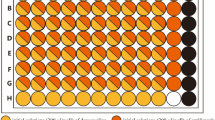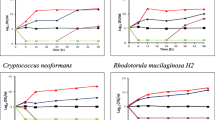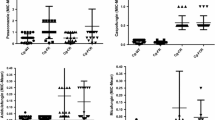Abstract
The microbiologic and clinical resistance of dermatophytes is seldom reported, and the mechanisms associated with resistance are not well known. This study investigated the effect of efflux pump modulators (EPMs) (i.e., haloperidol HAL and promethazine PTZ) and their inhibiting activity on the minimum inhibitory concentrations of itraconazole (ITZ) and fluconazole (FLZ) against selected M. canis strains. M. canis strains with low (≤ 1 μg/ml itraconazole and < 64 μg/ml fluconazole) and high (> 1 μg/ml itraconazole and ≥ 64 μg/ml fluconazole) azole MIC values were tested using Checkerboard microdilution assay. The disk diffusion assay, the minimum fungicidal concentration and the time-kill assay were also performed in order to confirm the results of checkerboard microdilution assay. The MIC values of ITZ and FLZ of M. canis decreased in the presence of subinhibitory concentrations of HAL and PTZ, the latter being more effective with a greater increased susceptibility. Synergism was observed in all strains with high azole MICs (FICI < 0.5) and no synergism in the strains with low azole MICs. A fungicidal activity was observed after 48 h of incubation when ITZ and FLZ were tested in combination with HAL or PTZ. These results suggest that the drug efflux pumps are involved in the defense mechanisms to azole drugs in M. canis strains. The synergism might be related to an increased expression of efflux pump genes, eventually resulting in azole resistance phenomena. Complementary studies on M. canis resistance are advocated in order to investigate the molecular mechanisms of this phenomenon.



Similar content being viewed by others
References
Cafarchia C, Romito D, Sasanelli M, Lia R, Capelli G, Otranto D. The epidemiology of canine and feline dermatophytosis in southern Italy. Mycoses. 2004;47:508–13.
Cafarchia C, Otranto D, Weigl S, Campbell BE, Parisi A, Cantacessi C, et al. Molecular characterization of selected dermatophytes and their identification by electrophoretic mutation scanning. Electrophoresis. 2009;30:3555–644.
de Hoog GS, Dukik K, Monod M, Packeu A, Stubbe D, Hendrickx M, et al. Toward a novel multilocus phylogenetic taxonomy for the dermatophytes. Mycopathologia. 2017;182(1–2):531.
Cafarchia C, Romito D, Capelli G, Guillot J, Otranto D. Isolation of Microsporum canis from the hair coat of pet dogs and cats belonging to pet owners diagnosed with M. canis tinea corporis. Vet Dermatol. 2006;17:327–31.
Ginter-Hanselmayer G, Weger W, Ilkit M, Smolle J. Epidemiology of tinea capitis in Europe: current state and changing patterns. Mycoses. 2007;50:6–13.
Moriello KA, Coyner K, Paterson S, Mignon B. Diagnosis and treatment of dermatophytosis in dogs and cats. Veterinary Dermatol. 2017;28:266–8.
Martins MP, Franceschini A, Jacob T, Rossi A, Martinez-Rossi NM. Compensatory expression of multidrug-resistance genes encoding ABC transporters in dermatophytes. J Med Microbiol. 2016;65:605–10.
Aneke CI, Otranto D, Cafarchia C. Therapy and antifungal susceptibility profile of Microsporum canis. J Fungi. 2018;4:107.
Ghannoum M. Azole resistance in dermatophytes: prevalence and mechanism of action. J Am Pediatr Med Assoc. 2016;106:79–86.
Galuppi R, Gambarara A, Bonoli C, Ostanello F, Tampieri MP. Antimycotic effectiveness against dermatophytes: comparison of two in vitro tests. Vet. Res. Commun. 2010;34:57–61.
Coelho LM, Ferreria RA, Leite Maffei CM, Martinez-Rossi NM. In-vitro antifungal drug susceptibilities of dermatophytes microconidia and arthroconidia. J. Antimicrob. Chemother. 2008;62:758–61.
Yamada T, Maeda M, Alshahni MM, Tanaka R, Yaguchi T, Bontems A, et al. Terbinafine resistance of Trichophyton clinical isolates caused by specific point mutations in the squalene epoxidase gene. Antimicrob. Agents Chemother. 2017;61:e00115–e117.
Hsiao YH, Chen C, Han HS, Kano R. The first report of terbinafine resistance Microsporum canis from a cat. J. Vet. Med. Sci. 2018;80:898–900.
Kano R, Hsiao Y, Han HS, Chen C, Hasegawa A, Kamata H. Resistance mechanism in a terbinafine-resistant strain of Microsporum canis. Mycopathologia. 2018;183:623.
Ughachukwu PO, Unekwe PC. Efflux pump-mediated resistance in chemotherapy. Ann Med Health Sci Res. 2012;2:191–8.
Martinez-Rossi NM, Peres NTA, Rossi A. Antifungal resistance mechanisms in dermatophytes. Mycopathologia. 2008;166:369–83.
Prasad R, Shah AH, Rawal MK. Antifungals: mechanism of action and drug resistance. Adv. Exp. Med. Biol. 2016;892:327–49.
Cannon RD, Lamping E, Holmes AR, Niimi K, Baret PV, Keniya MV, et al. Efflux-mediated antifungal drug resistance. Clin Microbiol Rev. 2009;22:291–32121.
Pfaller MA. Antifungal drug resistance: mechanisms, epidemiology, and consequences for treatment. Am J Med. 2012;125:S3–S13.
Iatta R, Puttilli MR, Immediato D, Otranto D, Cafarchia C. The role of drug efflux pumps in Malassezia pachydermatis and Malassezia furfur defense against azoles. Mycoses. 2017;60:178–82.
Holmes AR, Cardno TS, Strouse JJ, Ivnitski-Steele I, Keniya MV, Lackovic K. Targeting efflux pumps to overcome antifungal drug resistance. Future Med Chem. 2016;8:1485–501.
Brilhante RS, Castelo-Branco DS, Duarte GP, Paiva MA, Teixeira CE, Zeferino JP, et al. Yeast microbiota of raptors: a possible tool for environmental monitoring. Environ Microbiol Rep. 2012;4:189–93.
Wibawa T, Nur R, Baly I, Daeli PR, Kartasasmita G, Wijayanti N. Cyclosporine A decreases the fluconazole minimum inhibitory concentration of Candida albicans clinical isolates but not biofilm formation and cell growth. Trop Biomed. 2015;32:176–82.
de Hoog GS, Guarro J, Gené J, Figueras MJ. Atlas of Clinical Fungi. Amer Society for Microbiology. Centraalbureau voor Schimmelcultures/Universitat Rovira i Virgili, Utrecht/Reus. 2000.
Cafarchia C, Gasser RB, Figueredo LA, Weigl S, Danesi P, Capelli G, et al. An improved molecular diagnostic assay for canine and feline dermatophytosis. Med Mycol. 2013;51:136–43.
Clinical and Laboratory Standards Institute (CLSI). Reference method for broth dilution antifungal susceptibility testing of filamentous fungi. Approved standard M38-A. Clinical and Laboratory Standards Institute, Wayne, Pennsylvania, United States of America, 2008.
Barros MES, Santos DA, Hamdan JS. In vitro methods for antifungal susceptibility testing of Trichophyton spp. Mycol. Res. 2006;110:1355–60.
Santos DA, Barros MES, Hamdan JS. Establishing a method of inoculum preparation for susceptibility testing of Trichophyton rubrum and Trichophyton mentagrophytes. J Clin Microbiol. 2006;44:98–101.
Fernández-Torres B, Cabañes FJ, Carrillo-Munõz AJ, et al. Collaborative evaluation of optimal antifungal susceptibility testing condition for dermatophytes. J Clin Microbiol. 2002;40:3999–4003.
Ghannoum MA, Chaturvedi V, Espinel-Ingroff A, et al. Intra- and inter-laboratory study of a method for testing the antifungal susceptibilities of dermatophytes. J Clin Microbiol. 2004;42:2977–9.
Afeltra J, Vitale RG, Mouton JW, Verweij PE. Potent synergistic in vitro interaction between non antimicrobial membrane-active compounds and itraconazole against clinical isolates of Aspergillus fumigatus resistant to itraconazole. Antimicrob. Agents. Chemother. 2004;48:1335–433.
Odds FC. Synergy, antagonism, and what the chequerboard puts between them. J Antimicrob. Chemother. 2003;52:1.
Xu J, Liu R, Sun F, An L, Shang Z, Kong L, Yang M. Eucalyptal D enhances the antifungal effect of fluconazole on fluconazole-resistant Candida albicans by competitively inhibiting efflux pump. Front. Cell. Infect. Microbiol. 2019;9:211.
Canton E, Peman J, Viudes A, Quindos G, Gobernado M, Espinel-Ingroff A. Minimum fungicidal concentrations of amphotericin B for bloodstream Candida species. Diagn. Microbiol. Infect. Dis. 2003;45:203–6.
Ghannoum MA, Isham N. Voriconazole and caspofungin cidality against non-albicans Candida species. Infect. Dis. Clin. Pract. 2007;15:250–3.
Klepser ME, Ernst EJ, Lewis RE, Ernst ME, Pfaller MA. Influence of test conditions on antifungal time-kill curve results: proposal for standardized methods. Antimicrob. Agents Chemother. 1998;42:1207–12.
Tegos GP, Haynes M, Strouse JJ, Md T Khan M, Bologa C, Oprea T, et al. Microbial efflux pump inhibition: tactics and strategies. Curr. Pharm. Des. 2011;17:1291–302.
Jin J, Guo N, Zhang J, Ding Y, Tang X, Liang J, Li L, Deng X, Yu L. The synergy of honokiol and fluconazole against clinical isolates of azole-resistant Candida albicans. Lett. Appl. Microbiol. 2010;51:351–7.
Denardi LB, Mario DA, Loreto ES, Santurio JM, Alves SH. Synergistic effects of tacrolimus and azole antifungal compounds in fluconazole-susceptible and fluconazole resistant Candida glabrata isolates. Braz. J Microbiol. 2015;46:125–9.
Cantisati C, Ricci S, Grieco T, Paolino G, Faina V, Silvestri E, et al. Topical promethazine side effects: our experience and review of the literature. Biomed. Res. Int. 2013;2013:151509.
Kolaczkowski M, Michalak K, Motohashi N. Phenothiazines as potent modulators of yeast multidrug resistance. Int. J Antimicrob Agents. 2003;22:279–83.
Funding
This research received no external funding.
Author information
Authors and Affiliations
Contributions
Aneke Chioma Inyang and Cafarchia Claudia conceptualized the study and wrote the manuscript. Aneke Chioma Inyang and Rhimi Wafa performed the research. Aneke Chioma Inyang, Cafarchia Claudia and Otranto Domenico contributed to analysis and interpretation of the study data. Cafarchia Claudia and Otranto Domenico revised, edited and made intellectual inputs in the manuscript. All authors read and approved the final manuscript.
Corresponding author
Ethics declarations
Conflict of interest
The authors declare that they have no conflict of interest.
Ethical Approval
This article does not contain any studies with human participants or animals performed by any of the authors.
Additional information
Handling editor: Nilce M. Martinez-Rossi.
Publisher's Note
Springer Nature remains neutral with regard to jurisdictional claims in published maps and institutional affiliations.
Rights and permissions
About this article
Cite this article
Aneke, C.I., Rhimi, W., Otranto, D. et al. Synergistic Effects of Efflux Pump Modulators on the Azole Antifungal Susceptibility of Microsporum canis. Mycopathologia 185, 279–288 (2020). https://doi.org/10.1007/s11046-019-00419-7
Received:
Accepted:
Published:
Issue Date:
DOI: https://doi.org/10.1007/s11046-019-00419-7




